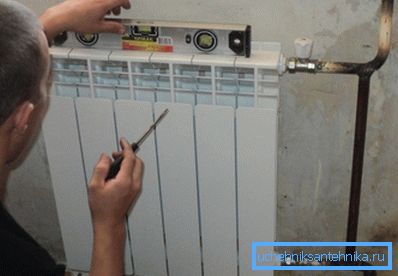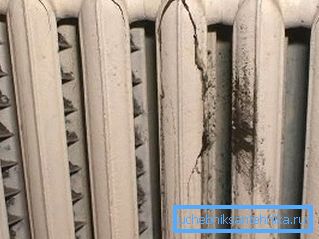Connecting radiator heating. circuit outline. insert
What is the correct connection of a heating radiator? We will analyze the connection diagrams used in private houses and city apartments, and used for this purpose pipes, fittings and elements of valves and fittings. In addition, we will find out what mistakes can be made in the design and installation of the heating system.

Circuit Outlines
If in a city apartment the scheme of the heating system as a whole or its individual loop does not depend on our efforts, in a private house the circuit is designed from scratch.
There are two fundamentally different schemes:
- Single pipe, representing the only bottling around the perimeter of the heated building. Heating devices crash parallel to the bottling.
Note: practicing and consistent installation of batteries; it is inconvenient because it does not allow independent adjustment of devices.
- Two-pipe - independent feed and reverse bottling. Each radiator acts as a jumper between them.
The advantages of the one-pipe scheme are low cost, ease of installation and exceptional fault tolerance. Disadvantages - a significant variation in temperature between the first and the last heating device, as well as the difficulty of laying around the perimeter of the house in the presence of high openings and panoramic windows.
The two-pipe scheme is devoid of these shortcomings, but under certain conditions it can create much more serious problems for the owner. The batteries closest to the boiler quench the difference between bottling, which slows down circulation in distant devices. That is why the two-pipe system requires mandatory balancing - throttling the supply lines and adjusting their throughput for temperature equalization.

This problem is elegantly managed in an associated two-pipe system - the Tichelman circuit, all the loops of which have equal length.

Insert radiators
What can be the ways of connecting radiators to bottling and risers?
| Title | Description | Special features |
| Side one-sided | Leads are connected to the upper and lower headers on one side of the heater | With a small number of sections provides maximum heat transfer. When the number of sections is over ten, the edge of the radiator furthest from the pipes will cool down. In the extreme sections over time accumulates silt |
| Bottom down | Leads connected to both bottom manifold plugs | The heat output of the device is slightly reduced due to the slow circulation through the upper collector. The radiator does not require flushing: the sections do not silt |
| Diagonal | Leads are connected to the upper stopper on one side of the radiator and the lower one on the other. | Heat transfer is maximum at any length of the radiator. The bottom of sections is silted up from the side of a deaf lower cork |

Please note: in a closed autonomous heating system, you can forget about the problem of silting batteries. A small amount of suspended solids in the coolant quickly collects in the mud tank and does not cause any problems in the future. Accordingly, it makes sense to choose the types of connection of radiators that will ensure maximum heat transfer.
Errors
Incorrect connection of radiators of heating can lead to malfunctioning of the DH system, autonomous circuit or seriously reduce the heat transfer of the device.
What mistakes can I make when installing batteries?
- Inset your radiator between the feed and return risers on any floor other than the top, will make your neighbors freeze on the riser. The coolant will circulate through the small ring - through your battery, but the heat transfer of all devices above the improvised jumper drops sharply.
- Insert radiator with any stop or throttling valves on the liner without a jumper in front of the valves or chokes. In this case, the blocked cock will stop the circulation in the entire riser.

- Lateral connection of a multi-section radiator, as already mentioned, will lead to a drop in the heat transfer of the extreme sections.
- Connection of heating radiators with a supply pipe of a reduced diameter will also lead to a drop in thermal power relative to the nominal one. The norm is a pipe DU15 (1/2 inch) with the number of sections up to seven and DNU20 (3/4 inch) with a larger number of sections.
Selection of materials
The choice of pipes, batteries and fittings affects the efficiency and safety of the heating system at least as much as its design. What materials should be preferred in different cases?
Central heating
The operating parameters of the central heating station (4-6 kgf / cm2, 40-95 C) seem to allow the use of any modern pipes, batteries and fittings.
However, practice shows that it is better to refuse some of their types:
- The calculated value of the temperature of the coolant is often exceeded in severe frosts. When mass complaints of cold in the apartments, the work of elevator nodes without a nozzle is sometimes practiced, with a muffled choke. In this mode, the batteries can heat up to 130 - 140 C.
- The abrupt closure of any element of valves and fittings due to the incompetence of a locksmith or breakdown will lead to a hydraulic shock with a short-term increase in pressure to 20-25 atmospheres.

It is the likelihood of emergency situations that leaves its mark on the choice of equipment for the central heating station.
Pipes
For the installation of liners can be used:
- Steel VGP (water and gas) pipe on welded joints;
- Galvanized VGP pipe threaded. Weld seams are contraindicated for its anti-corrosion coating: at high temperatures, zinc burns out;
- Corrugated stainless pipe on compression fittings.
The last option is attractive because it is easily mounted with your own hands using a simple tool - a pair of wrenches. The price of a corrugated pipe with a diameter of 1/2 inch is about 200 rubles per meter.

Radiators
In DH systems are used:
- Convectors, representing a coil of pipe with fins, increasing heat transfer;
- Bimetallic radiators. The steel core makes them resistant to pressure surges up to 25 - 40 kgf / cm2;
- In premises where aesthetics does not play a decisive role, the installation of home-made all-welded tubular radiators (registers) is practiced. As a rule, the connection of steel radiators is carried out by a black steel pipe at the welded joints.

Heating system
Pipes
Fully controlled parameters of autonomous circuits allow using inexpensive and durable polypropylene and metal-plastic pipes in them.
A couple of subtleties are associated with their installation:
- For metal-plastic, not compression joints are preferred, but press fittings that better tolerate multiple heating and cooling cycles;
- For polypropylene, reinforcement is desirable, which reduces the elongation of pipes when heated.
Radiators
Everything is simple here: our choice is cheap, aesthetic and high heat dissipation aluminum batteries.

Fittings and Fittings
For connecting the heater to cranes and pipes, American women have been used extensively in recent years - fittings with a cap nut, which make it possible to make the connection quick-release.
As the regulating and shutoff valves can be used:
- Ball Valves;
- Cone taps (chokes), which allow to regulate the heat transfer in manual mode;
- Thermostatic valves with thermal heads, allowing automatic maintenance of a given air temperature.
On the upper floors of apartment buildings, and in those cases where the upper radiator manifold is the top point of a separate loop loop, the radiator plug is equipped with a Mayevsky crane — an uncomplicated device for bleeding air plugs.

Conclusion
We hope that our review of wiring diagrams and materials used in heating systems will help the reader to make the right decision when planning their own repair or construction. The video in this article offers additional thematic information. Successes!